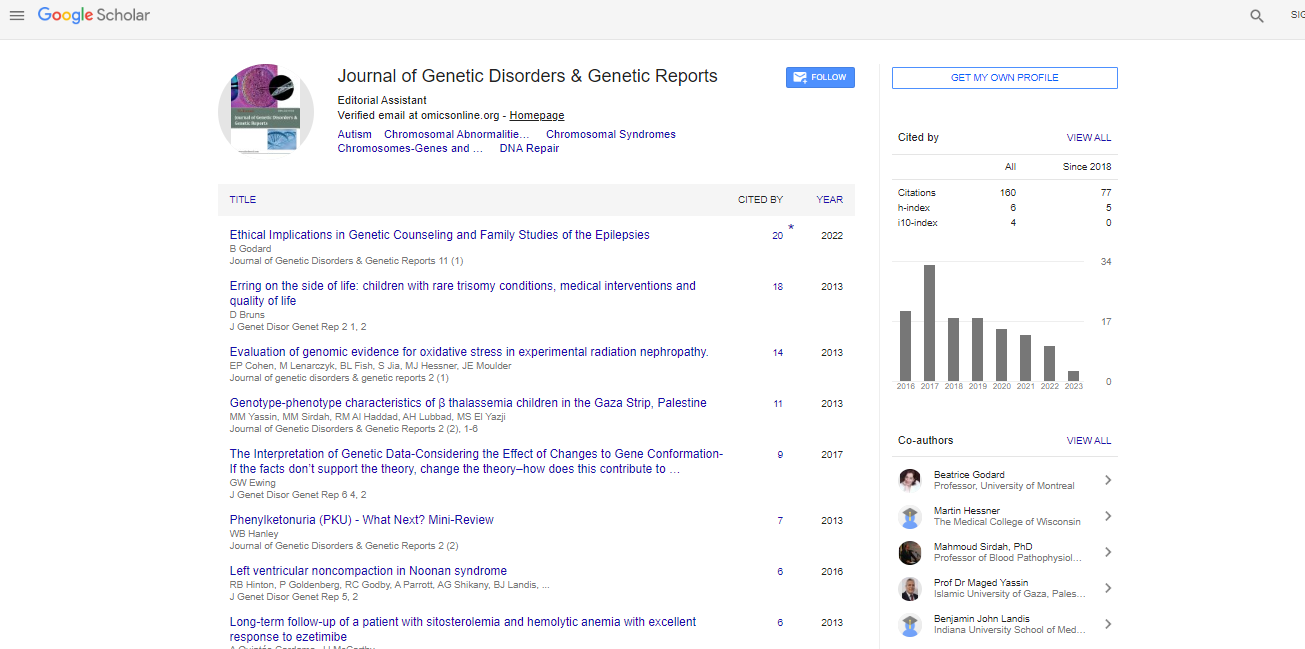Commentary, J Genet Disor Genet Rep Vol: 12 Issue: 5
Understanding the Genetic Basis, Clinical Manifestations, and Therapeutic Approaches for Congenital Adrenal Hyperplasia
Farid Ahmed*
1Department of Medical Genetics, National Institute of Genetic Engineering and Biotechnology, Tehran, Iran
*Corresponding Author: Farid Ahmed,
Department of Medical Genetics, National
Institute of Genetic Engineering and Biotechnology, Tehran, Iran
E-mail: ahmedfarid0@gmail.com
Received date: 25 September, 2023, Manuscript No. JGDGR-23-120545;
Editor assigned date: 28 September, 2023, PreQC No. JGDGR-23-120545 (PQ);
Reviewed date: 12 October, 2023, QC No. JGDGR-23-120545;
Revised date: 19 October, 2023, Manuscript No. JGDGR-23-120545 (R);
Published date: 26 October, 2023, DOI: 10.4172/2576-1439.1000224.
Citation: Ahmed F (2023) Understanding the Genetic Basis, Clinical Manifestations, and Therapeutic Approaches for Congenital Adrenal Hyperplasia. J Genet Disor Genet Rep 12:5.
Description
Congenital Adrenal Hyperplasia (CAH) is a group of genetic disorders characterized by enzymatic deficiencies in the biosynthesis of cortisol and aldosterone. The comprehensive overview of CAH, addressing its genetic basis, clinical manifestations, diagnostic challenges, and current therapeutic approaches. Additionally, it discusses the importance of early detection and management in improving patient outcomes.
Congenital Adrenal Hyperplasia (CAH) comprises a set of autosomal recessive disorders that result from mutations in genes encoding enzymes involved in the synthesis of cortisol and aldosterone in the adrenal glands. The most common form of CAH is due to mutations in the CYP21A2 gene, leading to 21-hydroxylase deficiency. This enzymatic defect disrupts the synthesis of cortisol and aldosterone, resulting in an overproduction of androgens.
Genetic basis
CAH is primarily caused by mutations in genes associated with adrenal steroidogenesis. The CYP21A2 gene mutations, accounting for about 95% of CAH cases, lead to 21-hydroxylase deficiency, the hallmark of the disease. Other less common forms of CAH include 11β-hydroxylase deficiency and 3β-hydroxysteroid dehydrogenase deficiency, each arising from mutations in their respective genes.
Clinical manifestations
The clinical presentation of CAH varies depending on the severity of the enzyme deficiency. Classic CAH, with complete loss of 21- hydroxylase activity, manifests in the neonatal period with saltwasting crises. Ambiguous genitalia in females and accelerated growth in both sexes may also be observed. Non-classic CAH, characterized by partial enzyme deficiency, often presents later in life with symptoms such as premature adrenarche, hirsutism, and menstrual irregularities in females.
Diagnostic challenges
Diagnosing CAH can be challenging due to the variability in clinical presentation and the existence of non-classic forms. Newborn screening programs have been implemented in many countries to identify affected infants early, allowing prompt intervention to prevent life-threatening salt-wasting crises. Diagnosis involves measuring serum 17-hydroxyprogesterone levels, but interpretation can be confounded by factors such as age, stress, and intercurrent illness.
Therapeutic approaches
The management of CAH aims to replace deficient hormones, suppress androgen excess, and prevent adrenal crises. Glucocorticoid replacement therapy, such as hydrocortisone or prednisolone, is administered to replace cortisol. Mineralocorticoid replacement with fludrocortisone is essential in salt-wasting forms of CAH. Monitoring growth, bone health, and hormonal levels is important to adjusting therapy and optimizing outcomes.
Surgical interventions
Genital reconstructive surgery may be considered in females with ambiguous genitalia, but the timing and necessity of such procedures are subjects of ongoing debate. Careful consideration of psychological and social factors is essential in the decision-making process.
Long-term management and follow-up
Patients with CAH require lifelong medical supervision to ensure appropriate hormone replacement and to monitor for complications such as osteoporosis and metabolic syndrome. Regular follow-up visits should include hormonal assessments, bone densitometry, and assessment of psychosocial well-being.
Future perspectives
Advances in genetic testing and molecular diagnostics continue to enhance our understanding of CAH. Emerging therapies, such as gene therapy and pharmacological interventions targeting the enzymatic defects, hold promise for more targeted and effective treatments. Additionally, ongoing research aims to improve the understanding of the genotype-phenotype correlations, allowing for more personalized approaches to patient care.
Conclusion
Congenital Adrenal Hyperplasia is a complex genetic disorder that requires a multidisciplinary approach for effective management. Early diagnosis, appropriate hormone replacement, and vigilant long-term follow-up are important for optimizing outcomes and improving the quality of life for individuals affected by CAH. Ongoing research and technological advancements offer hope for continued improvements in diagnostic accuracy and therapeutic options, paving the way for a brighter future for those living with this challenging condition.




